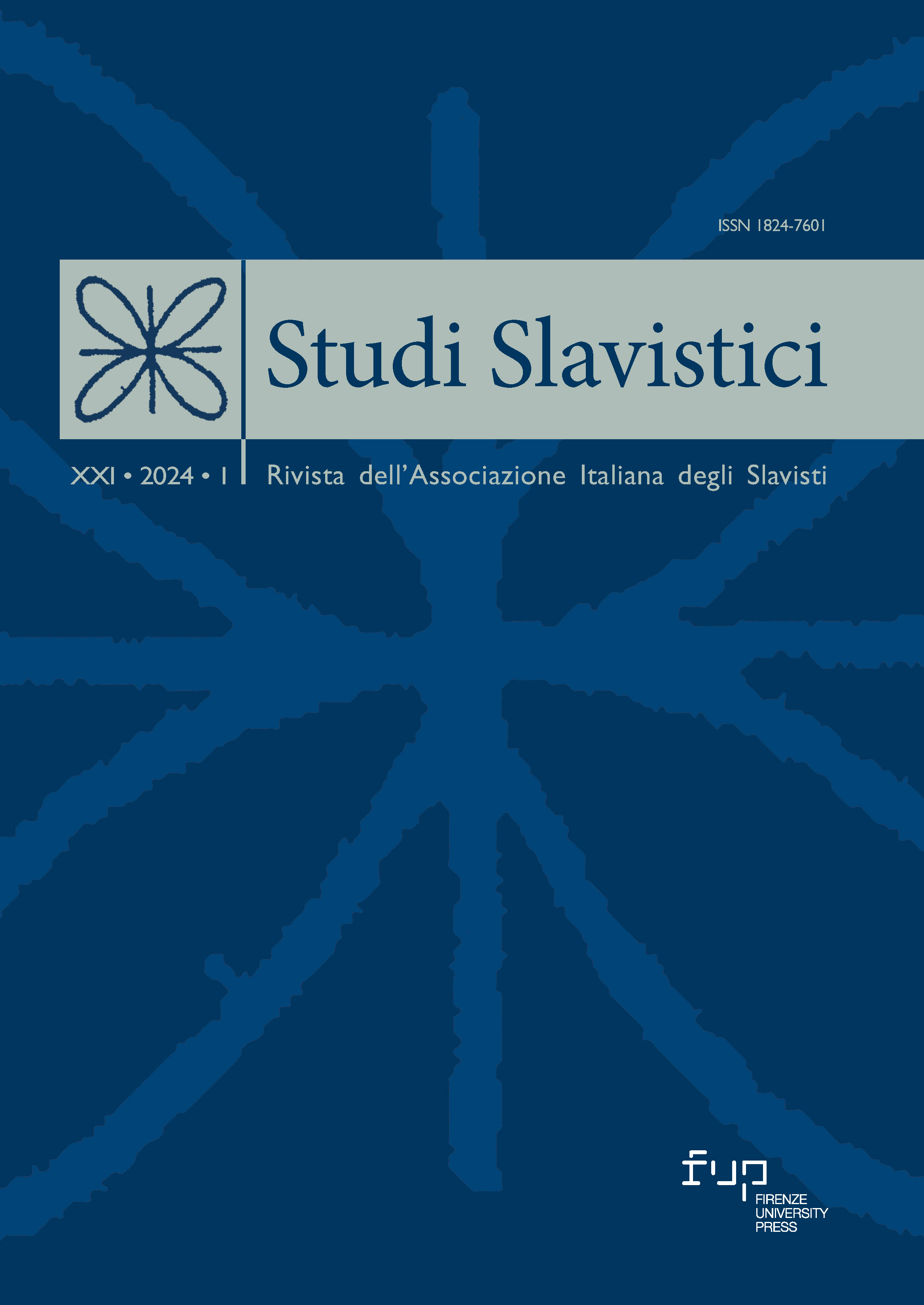Published 2024-07-11
Keywords
- syllable structure,
- Polish,
- sonorants
Copyright (c) 2024 Irena Sawicka, Tatiana Zinowjewa

This work is licensed under a Creative Commons Attribution 4.0 International License.
Abstract
A change has been observed in the pronunciation of sonorants in Polish in positions where their occurrence does not conform with the sonority principle. It has been decided to take a closer look at this process and begin research on this phenomenon. First, we plan to examine the pronunciation of sonorants in word-final positions after an obstruent, next we will examine them in the position between two obstruents, and finally in the word-initial position before an obstruent. So far, a short pilot study has been published (Sawicka, Zinowjewa 2020), and the pronunciation of /w/ has been examined in sentences read by a selected speaker (Sawicka, Zinowjewa 2023). The present study discusses the pronunciation of r in sentences read by the same speaker. The project will also include an examination of the same material read by a greater number of “average” speakers of Polish, and an examination of continuous material – longer texts, read and spoken.
References
- Beňuš, Pouplier 2011: Š. Beňuš, M. Pouplier, Jaw movement in vowels and liquids forming the syllable nucleus, “Interspeech”, 2011, pp. 389-392.
- Bethin 1992: Ch. Bethin, Polish syllables. The role of prosody in phonology and morphology, Columbus (oh) 1992.
- Boersma, Weenink 1992-2016: P. Boersma, D. Weenink, Praat: Doing phonetics by computer, .
- Bogusławski 1985: A. Bogusławski, Sylaba a system fonologiczny, “Prace Filologiczne” xxxii, 1985, pp. 59-65.
- Bogusławski 1990: A. Bogusławski, What’s in a phonological syllable? Universal constraints on the composition of syllables and the Slavonic data, “Wiener Slawistischer Almanach”, 1990, 25-26, pp. 111-125.
- De Jong, Wempe 2009: N.H. De Jong, T. Wempe, Praat script to detect syllable nuclei and measure speech rate automatically, “Behavior Research Methods”, xli, 2009, 2, pp. 385-390.
- Dukiewicz, Sawicka 1995: L. Dukiewicz, I. Sawicka, Gramatyka współczesnego języka polskiego, Fonetyka i fonologia, Kraków 1995.
- Duma 1990: J. Duma, Rozwój sonantów zgłoskotwórczych w gwarach południowo-wschodniej słowiańszczyzny, Wrocław 1990.
- Gladney 2004: F. Gladney, On sonorants and syllabicity in Polish, “Bulletin de la Société polonaise de linguistique” lx, 2004, pp. 117-132.
- Gonet 1993: W. Gonet, Próba określenia normy wymowy polskich samogłosek ustnych, w: S. Grabias (red.), Opuscula logopedia in honorem Leonis Kaczmarek, Lublin 1993, pp. 232-253.
- Kleśta 1998: J. Kleśta, Lingwistyczne i para lingwistyczne zastosowania akustyczno-fonetycznej bazy danych samogłosek języka polskiego, “Technologia mowy i języka”, ii, 1998, pp. 47-64
- Madejowa 1981: M. Madejowa, Tendencje wymawianiowe we współczesnej polszczyźnie literackiej, “Studia polonistyczne”, 1981, 9, pp. 91-95.
- Nakagawa, Hashimoto 1988: S. Nakagawa, Y. Hashimoto, A method for continuous speech segmentation using HMM, in: Proceedings of 9th International Conference on Pattern Recognition, ii, Rome 1988, pp. 960-962, doi: 10.1109/ICPR.1988.28414.
- Nagarajan et al. 2003: T. Nagarajan, H.A. Murthy, M. Rajesh, M. Hegde, Segmentation of speech into syllable-like units, “Eurospeech – Geneva 2003”, pp. 2893-2896.
- Ohala 1992: J. Ohala, Alternatives to the sonority hierarchy for explaining segmental sequential constraints, in: Papers from the Parasession on the Syllable, Chicago 1992, pp. 319-338.
- Osowicka-Kondratowicz 2011: M. Osowicka-Kondratowicz, Zmiany dźwiękowej strony współczesnej polszczyzny, in: I. Matusiak-Kempa, S. Przybyszewski (red.), Nowe zjawiska w języku, tekście i komunikacji, iii (Kontekst a komunikacja), Olsztyn 2011, pp. 65-72.
- Osowicka, Serowik 2007: M. Osowicka, A. Serowik, Palatalność asymilacyjna w języku polskim, w: I. Sawicka (red.), Komparacja współczesnych języków słowiańskich, Fonetyka i fonologia, Opole 2007, pp. 61-102.
- Parker 2002: S. Parker, Quantifying the sonority hierarchy (submitted to the Graduate School of the University of Massachusetts Amherst in partial fulfillment of the requirements for the degree of Doctor of Philosophy).
- Rubach, Booij 1990: J. Rubach, G., Booij, Syllable structure assignment in Polish, “Phonology”, vii, 1990, pp. 121-158.
- Sawicka 2015: I. Sawicka, Struktura e rrokjes arbëreshe, in: Studi in onore del Prof. Francesco Altimari in occasione del 60° compleanno, Tiranë 2015, pp. 599-609.
- Sawicka 2018: I. Sawicka, Arberesh syllable pattern, in: T. Kahl, I. Krapova, G. Turano (eds.), Balkan dialectology. “Balkan” enclaves in Italy. Languages, dialects, identities: Proceedings from the Sixth Meeting of the Commission for Balkan Linguistics of the International Committee of Slavists, Cambridge 2018, pp. 77-90.
- Sawicka, Zinowjewa 2020: I. Sawicka, T. Zinowjewa, The pronunciation of final clusters of the type -tr in Polish, “Studies in Polish Linguistics”, xv, 2020, 2, pp. 85-102.
- Sawicka, Zinowjewa, 2023: Sawicka I., Zinowjewa T., Wymowa wygłosowych grup spółgłoskowych o opadająco-rosnącej sonorności w języku polskim, in: M. Głuszkowski, P. Zemszał (eds.), Wokół języka i kultury. Prace dedykowane prof. Stefanowi Grzybowskiemu w 80. rocznicę urodzin, Toruń 2023, pp. 161-195.
- Sawicka et al. 2022: I. Savicka, A. Travinjska, V. Labroska, A. Cihnerska, B. Gerazov, Fonetika i fonologija na makedonskiot standarden jazik. Segmentalna fonetika i fonologija, Skopje 2022, <http://ical.manu.edu.mk/books/Segmentalna%20fonologija.pdf>.
- Steffen-Batogowa 1996: M. Steffen-Batogowa, On the pronunciation of some Polish consonantal clusters containing sonorants, “Studia Phonetica Posnaniensia”, 1996, 5, pp. 61-85.
- Strycharczuk 2012: P. Strycharczuk, Sonorant transparency and the complexity of voicing in Polish, “Journal of Phonetics”, 2012, 40, pp. 655-671.
- Szpyra-Kozłowska 1998: J. Szpyra-Kozłowska, The sonority scale and phonetic syllabification in Polish, “Bulletin de la Société polonaise de linguistique”, liv, 1998, pp. 63-79.
- Zinowjewa 2018: T. Zinov’eva, Ešče raz o final’nych klasterach s sonantami, “Linguistica Copernicana”, xv, 2018, pp. 277-289.

